|
Welcome to
the tour of the Historic Markers that have been
placed by the Hannah Caldwell Chapter, Daughters of
the American Revolution, Davenport, Iowa
The Hannah Caldwell Chapter,
organized on January 18, 1897, has worked actively
throughout its history toward historic preservation.
In 1903 chapter members began planning and making
preparations to mark sites in our community worthy of historic
recognition.
It took 14 years of preparation before the first marker
was dedicated. Hannah Caldwell is proud of its tradition
of preserving local history in keeping with the DAR
objectives.
|
Major Zachary
Taylor led the United States troops in boats
from the river. The Sac and Fox Indians
were under a British Lieutenant, and the Sioux
and Winnebago Indians were under Chief Black
Hawk on the Iowa side of the
river. This was the only "international"
conflict that ever occurred in Iowa, and the
only battle Zachary Taylor ever lost.
Originally this
marker was placed at the entrance of the
Island. It now stands on the west
side of the island beside
carved wooden figures titled "Sunday in the
Park." This scene was modeled after the
painting "A Sunday on La Grande Jatte"
by Georges Seurat. It is fitting that our
marker has been moved and included as a part of
this prominent point of interest.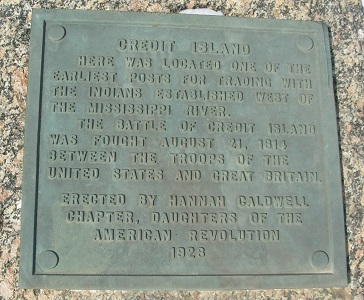
Credit Island is
on the west edge of Davenport, surrounded by the
Mississippi River. The inscription
reads:
Credit
Island. Here was located one of the
earliest posts for trading with the Indians
established west of the Mississippi
River. The battle of Credit Island was
fought August 21, 1814 between troops of the
United States and Great Britain.
Erected by Hannah Caldwell Chapter Daughters
of the American Revolution 1928.
|
|
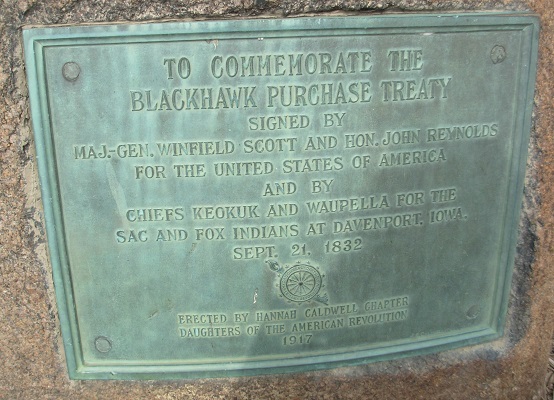 The Blackhawk Treaty
commemoration is in LeClaire Park, near the
beautiful Davenport riverfront. The Black
Hawk Treaty gave the United States 30 million
acres of land constituting what is now eastern
Iowa. The treaty was signed in General
Scott's tent, which was pitched on the present
East 5th Street between Farnam and LeClaire
streets. The Blackhawk Treaty
commemoration is in LeClaire Park, near the
beautiful Davenport riverfront. The Black
Hawk Treaty gave the United States 30 million
acres of land constituting what is now eastern
Iowa. The treaty was signed in General
Scott's tent, which was pitched on the present
East 5th Street between Farnam and LeClaire
streets.
The
inscription on the marker reads:
To commemorate the Black Hawk Purchase
Treaty, Signed by Major General Winfield
Scott and Honorable John Reynolds for the
United States and by Chiefs Keokuk and
Waupello for the Sac and Fox Indians at
Davenport, Iowa, September 21, 1832
Erected by Hannah Caldwell Chapter
DAR 1917
|
|
In the Village of East
Davenport going east on 12th
Street, and just past Jersey Ridge Road, is the
beautiful Lindsay Park overlooking the 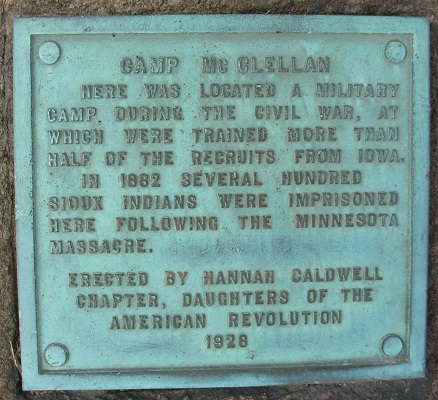 banks of the
Mississippi River. This was the site of
Camp McClellan, one of five Civil War camps in
and around the city between 1860-1865. banks of the
Mississippi River. This was the site of
Camp McClellan, one of five Civil War camps in
and around the city between 1860-1865.
The Marker reads:
Here was located a
military camp during the Civil War at
which were trained more than half of the
recruits from Iowa. In 1862 several
hundred Sioux Indians were imprisoned here
following the Minnesota massacre.
Erected by Hannah Caldwell Chapter
Daughters of the American Revolution 1928.
|
CAMP ROBERTS -
ANNIE WITTENMYER HOME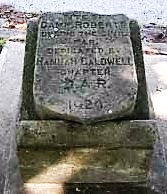
The Civil War
had a great impact on this area. At
2800 Eastern Avenue, across from
Oakdale Cemetery, is another Civil War
site, Camp Roberts. In May of 1863,
General Roberts became the Commander for the
Iowa District with headquarters in
Davenport. General Roberts selected this
site as a "temporary" camp for the 8th and 9th
Calvary. Later the camp was renamed
after Colonel Kinsman, a much loved and
courageous leader who lost his life at
Vicksburg while leading a valiant charge.
On November
22, 1865 Annie Wittenmyer confiscated these
abandon buildings by moving in 180 war orphans
while permission for such a move was still
being debated in Washington, D.C. Due to
the extravagant design of the camp and the
determination of Miss Wittenmyer, the Home
became the prototype for orphanages throughout
the United States and was later renamed in her
honor.
A limestone
marker was placed to mark the site of Camp
Roberts at the Annie Wittenmyer Home.
The
inscription reads:
Site of
Camp Roberts during the Civil War, Dedicated
by Hannah Caldwell Chapter DAR 1929.
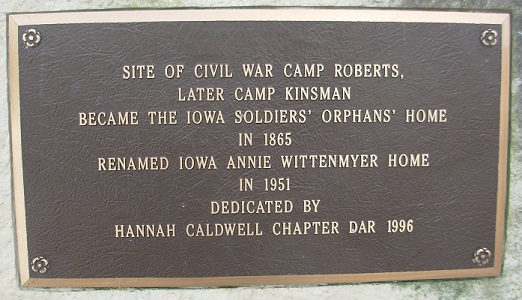 This
marker was being eroded due to the
weather. In 1996 as an Iowa
Sesquicentennial Project, the Hannah Caldwell
Chapter updated the history, re-dedicating
this site with a new stone and plaque, which
reads: This
marker was being eroded due to the
weather. In 1996 as an Iowa
Sesquicentennial Project, the Hannah Caldwell
Chapter updated the history, re-dedicating
this site with a new stone and plaque, which
reads:
Site of
Civil War Camp Roberts, Later Camp Kinsman
Became the Iowa Soldiers' Orphans' Home in
1865
Renamed Iowa Annie Wittenmyer Home in
1951.
Dedicated by
Hannah Caldwell Chapter DAR 1996
|
WESTERN
ABUTMENT OF FIRST BRIDGE ACROSS MISSISSIPPI
RIVER
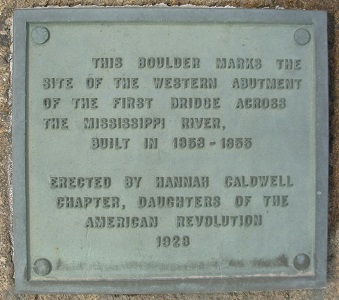 Along the north side of River Drive at
the intersection of East Fourth St. is the
marker commemorating the western abutment
of the first bridge across the Mississippi
River, joining the railroads in Davenport. Along the north side of River Drive at
the intersection of East Fourth St. is the
marker commemorating the western abutment
of the first bridge across the Mississippi
River, joining the railroads in Davenport.
The river,
not land, had been the main method of
transportation. Rivermen looked at this
obstruction placed in their river as a danger,
and in fact in 1856, the steamboat "Effie Afton"
met her demise when she struck a pier and burned
just two weeks after the opening of the
bridge. The Railroad Bridge Company was
successfully defended by Abraham Lincoln in the
lawsuit filed by the owners of the steamboat.
The inscription of this
marker reads:
This boulder marks the site of the
western abutment of the first bridge across
the Mississippi River built in 1853-55.
Erected by Hannah Caldwell Chapter Daughters
of the American Revolution 1928.
Beside our marker is a
replica of the Bridge abutment which was placed
by the Scott County Historical society in 1956.
|
HOME OF
RIVERBOAT CAPTAINS; FIRST WHITE SETTLERS IN
SCOTT CO.
At the west
edge of Buffalo on the north
side of highway 22 is a most unusual boulder
marking the home of the riverboat
captains, the first white
settlers in Scott County, Iowa.
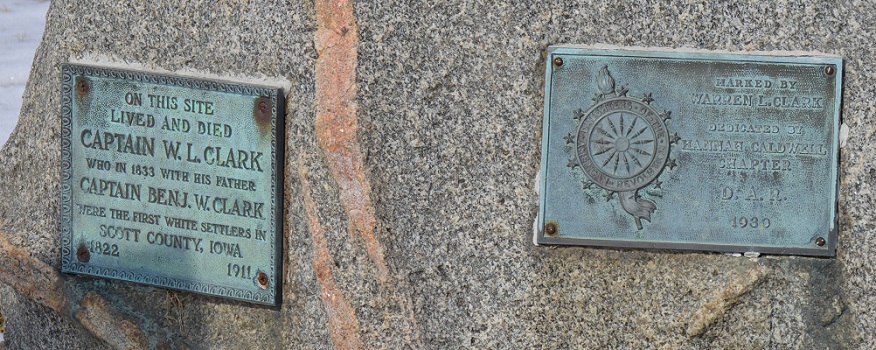
The first inscription
reads:
On this site lived and
died Captain W.L. Clark who in 1833 with his
father Captain Ben. W. Clark were the first
white settlers in Scott county, Iowa
1822-1911
And on the second plaque:
Marked by Warren L.
Clark.
Dedicated by Hannah Caldwell Chapter DAR 1930
|
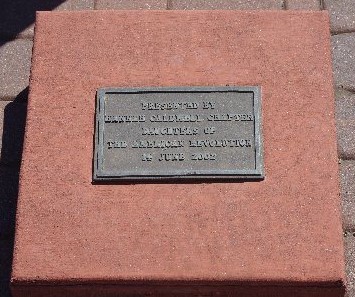
GERMAN
AMERICAN HERITAGE CENTER
FLAG POLE
The German American
Heritage Center is located at the foot of
Gaines, across from the YMCA, and just before
the Centennial Bridge. On August 6, 2002,
the Hannah Caldwell Chapter dedicated the flag
pole.
Presented By
Hannah Caldwell Chapter Daughters of the
American Revolution
14 June 2002
|
GRAND
ALLEE OF TREES - VANDERVEER PARK
VanderVeer Park
is located at Central Park and Main
Street. In 1904 Hannah Caldwell
Chapter NSDAR planted an Osage orange tree
here. It was grown from a seed planted at
the time the cornerstone of Centennial Hall was
laid in Washington, D.C. The soil came
from the site of Centennial Hall. This
tree was cut down a number of years ago.
The Friends of VanderVeer Park have developed
plans to restore this beautiful landmark to its
former splendor. A Grand Allee of 100
trees has been planted extending south from the
Rose Garden to the Fountain. Hannah
Caldwell Chapter was a part of this worthwhile
community project.
|
MARION
CRANDELL MEMORIAL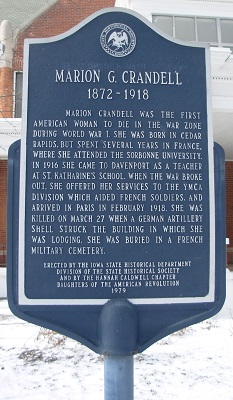
In the Annie
Wittenmyer Circle, 2800 Eastern, is the
Marion Crandell Memorial. Miss Crandall
was born in Cedar Rapids and spent time teaching
in Davenport.
The inscription reads:
Memorial to Miss
Marion Crandall, the first American Woman to
die in active service in World War I.
Marion Crandall was killed March 27, 1918 at
St. Menehould. She was buried in a
French military cemetery. Miss Crandall
came to Davenport in 1916 as a teacher at St.
Katherine's School.
Erected in cooperation with the Iowa State
Historical Society. November 1, 1979
|
Miss Sudlow came to
Davenport as a teacher in 1858. In 1872
she became the first woman high school
principal in the United States.
In 1877 Miss Sudlow was
elected president of the Iowa State Teacher's
Association and the following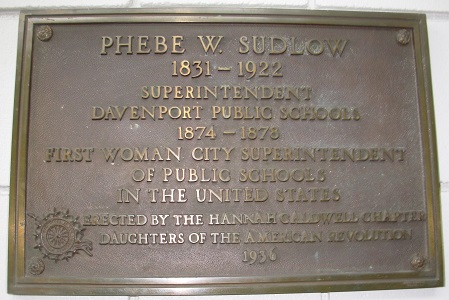 year
accepted a professorship at the University of
Iowa. year
accepted a professorship at the University of
Iowa.
Sudlow Intermediate
School is located at 1414 East Locust Street
and Esplanade Ave. Entering the large
hall from Pleasant Street
side, the Phoebe W. Sudlow plaque is on the
wall to your left.
It reads:
Phoebe W.
Sudlow, 1831-1922, Superintendent
Davenport Public Schools 1874-78 First
woman City Superintendent of Public Schools
in the United States.
Erected by Hannah Caldwell Chapter Daughters
of the American Revolution 1936.
|
|

